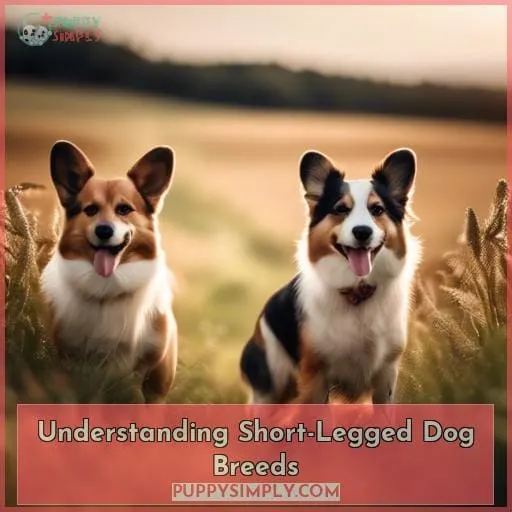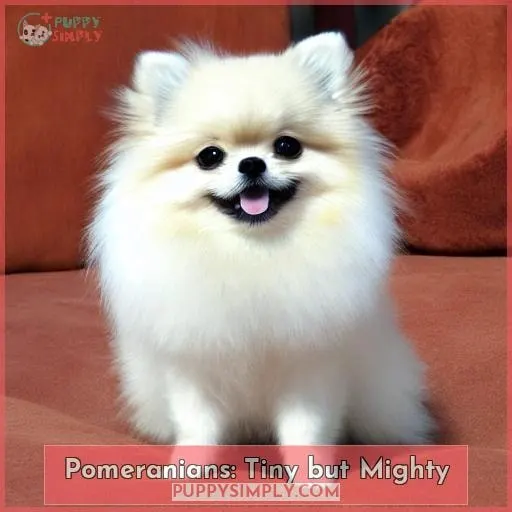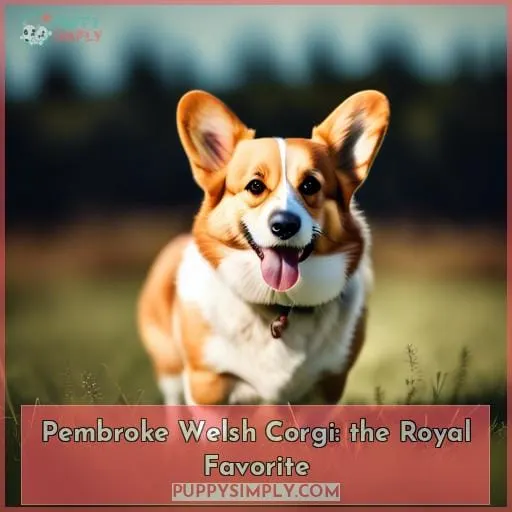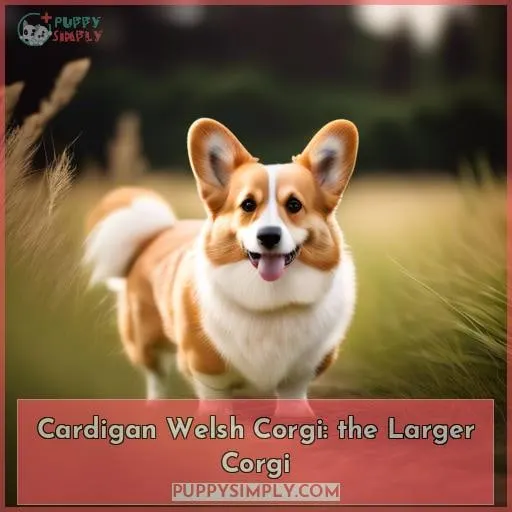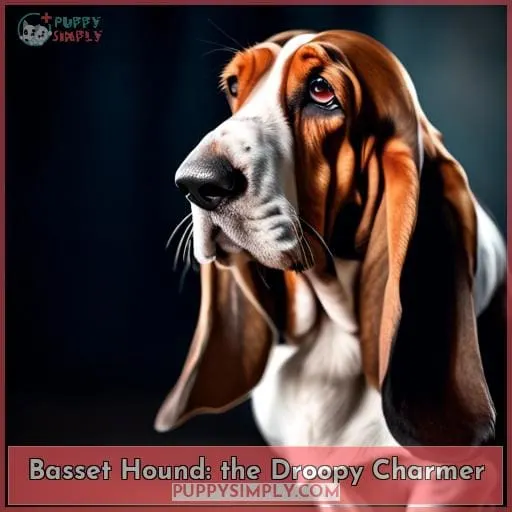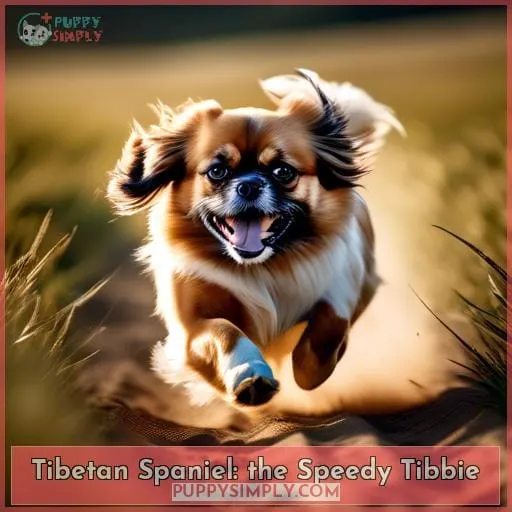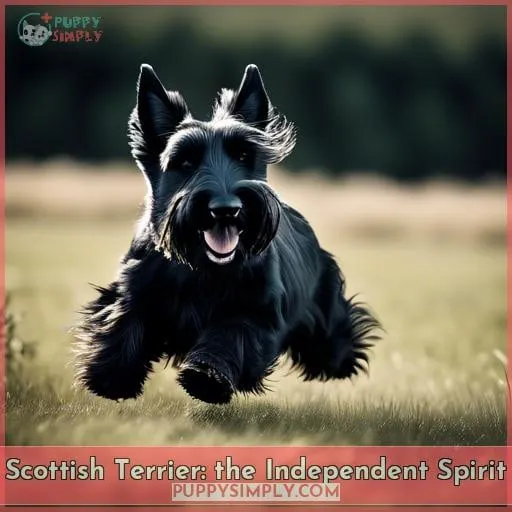This site is supported by our readers. We may earn a commission, at no cost to you, if you purchase through links.
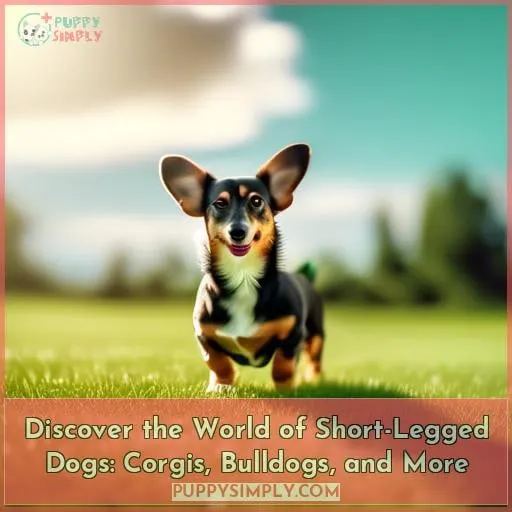 You’re ready for a dog, but you’re looking for one with a unique look, personality, and stature.
You’re ready for a dog, but you’re looking for one with a unique look, personality, and stature.
Don’t overlook dogs with short legs!
These pint-sized pooches, like Corgis and Bulldogs, have stolen hearts for centuries with their charming appearance, friendly nature, and unwavering loyalty.
Explore the world of short-legged dogs and discover why these petite pups are anything but small when it comes to love, companionship, and entertainment.
Table Of Contents
- Key Takeaways
- Understanding Short-Legged Dog Breeds
- Pomeranians: Tiny but Mighty
- Pembroke Welsh Corgi: the Royal Favorite
- Cardigan Welsh Corgi: the Larger Corgi
- American Bulldog: the Stout Companion
- Basset Hound: the Droopy Charmer
- Tibetan Spaniel: the Speedy Tibbie
- French Bulldog: the City Dweller’s Choice
- Scottish Terrier: the Independent Spirit
- The Genetics Behind Short Legs in Dogs
- Frequently Asked Questions (FAQs)
- What are some common health issues associated with short-legged dog breeds?
- Are there any specific dietary considerations for short-legged dogs?
- How can I prevent injuries in my short-legged dog during playtime or exercise?
- Are there any special training methods or techniques recommended for short-legged dogs?
- How can I ensure my short-legged dog receives adequate mental stimulation and enrichment?
- Conclusion
Key Takeaways
- Short-legged dog breeds are popular for their compact sizes, trainability, and lively spirits.
- Common short-legged dog breeds include Corgis, Bulldogs, and Basset Hounds.
- Pomeranians and Pembroke and Cardigan Welsh Corgis are specific examples of short-legged dogs.
- Short-legged dogs require preventive measures like supportive environments and healthy weight to prevent health issues like herniated discs.
Understanding Short-Legged Dog Breeds
You’ll find short-legged dogs share common traits:
- Compact sizes
- Trainability
- Lively spirits
Whether you prefer the fluffy Corgi, the stout Bulldog, or the droopy Basset Hound, these breeds bring joy and companionship to families and active individuals alike.
The Appeal of Short-Legged Dogs
You’re drawn to short-legged dogs for their unique charm and appealing features.
These canine cuties, with their disproportionate limbs, embody a captivating blend of cuteness and character.
Their compact stature makes them easy to handle and cuddle, while their playful personalities bring joy and laughter to your home.
Whether it’s the feisty Pomeranian, the loyal Pembroke Welsh Corgi, or the laid-back Basset Hound, short-legged dogs offer a world of companionship and unconditional love.
Common Characteristics of Short-Legged Dogs
Now that you’re aware of the appeal of short-legged dogs, let’s explore their common characteristics.
These dogs are often small and inherently agile, making them ideal for navigating tight spaces and rough terrain.
However, their short legs can also make them prone to certain health issues, such as herniated discs.
Therefore, it’s crucial to take preventive measures like providing a supportive environment and maintaining a healthy weight.
Despite these considerations, short-legged dogs have thrived throughout history, showcasing their adaptability and resilience.
From the corgi’s herding prowess to the bulldog’s unwavering loyalty, these breeds have earned a special place in our hearts.
Pomeranians: Tiny but Mighty
Let’s embark on a journey into the world of Pomeranians,
the tiny but mighty short-legged dogs known for their playful and devoted personalities.
Their beautiful double coats demand regular grooming,
but their intelligence makes them easy to train and effective watchdogs.
Physical Characteristics of Pomeranians
Let’s delve into the physical traits that make Pomeranians such distinctive and charming canines.
Their petite frames, weighing around eight pounds, exude an aura of elegance.
Their fluffy coats, available in a rainbow of colors, demand attention and regular grooming.
With their lively eyes and alert expressions, Pomeranians make excellent watchdogs, ever vigilant and ready to sound the alarm.
Temperament and Training of Pomeranians
Pomeranians’ bold and lively demeanor makes them great companions.
Training is a breeze with these intelligent pups; they respond well to positive reinforcement and enjoy learning new tricks.
Socialization is key to prevent shyness or aggression.
Daily walks and playtime keep them happy and healthy.
Grooming Needs of Pomeranians
To keep your Pomeranian’s beautiful double coat in its best condition, you’ll need to groom them three to five times a week.
- Use a soft brush to remove tangles and mats.
- Bathe your Pomeranian every four to six weeks.
- Trim their nails regularly.
- Clean their ears to prevent infections.
Pembroke Welsh Corgi: the Royal Favorite
As you explore the world of short-legged dogs, you’ll discover the Pembroke Welsh Corgi.
Beloved by royalty and known for its distinctive physical features, friendly temperament, and easy trainability, this breed is a great choice for busy families.
Grooming needs are minimal.
Physical Features of Pembroke Welsh Corgis
Now, let’s explore the Pembroke Welsh Corgi’s sturdy legs and muscular build, which give them their distinctive appearance.
Their coats come in a variety of colors, including red, sable, and tricolor.
Their tails are typically docked, and their ears are erect and fox-like.
Despite their short legs, they’re surprisingly agile and energetic, though they can be prone to intervertebral disk disease.
Temperament and Training of Pembroke Welsh Corgis
Pembroke Welsh Corgis’ intelligence and eagerness to please make them highly trainable companions.
Their royal obedience and agility prowess make them stars in canine sports.
As intelligent companions, they thrive on training regimens, building a strong bond and camaraderie.
Grooming Needs of Pembroke Welsh Corgis
When it comes to grooming, your Pembroke Welsh Corgi’s thick double coat requires regular brushing and occasional baths.
Brush often:
- Dedicate time each week to brush your Corgi’s coat.
- Remove loose hair and prevent mats.
Bathe occasionally:
- Your Corgi doesn’t need frequent baths.
- Occasional bathing keeps their coat clean and healthy.
Trim nails regularly:
- Keep your Corgi’s nails trimmed.
- Prevent them from becoming too long and causing discomfort.
Check ears and teeth:
- Regularly inspect your Corgi’s ears for signs of infection.
- Inspect their teeth for signs of decay.
Cardigan Welsh Corgi: the Larger Corgi
As you explore the captivating world of short-legged dogs, let’s focus on the Cardigan Welsh Corgi, a slightly larger version of its Pembroke counterpart.
Known for its intelligence, loyalty, and affectionate nature, the Cardigan Welsh Corgi thrives on mental stimulation and exercise, making it an ideal companion for active families.
Its distinct rounded ears and long, foxlike tail add to its charm, while its grooming needs are relatively manageable with regular brushing.
Physical Characteristics of Cardigan Welsh Corgis
And now, let’s explore the physical characteristics of Cardigan Welsh Corgis, a slightly larger breed compared to their Pembroke counterparts.
Their distinctive tails, unique coloring, and athletic build make them stand out.
These intelligent and robust dogs possess an independent spirit and a zest for life.
| Feature | Description |
|---|---|
| Size | Slightly larger than Pembroke Welsh Corgis |
| Weight | 25 to 38 pounds |
| Height | 10 to 12 inches at the shoulder |
| Coat | Double coat with a thick undercoat and a medium-length outer coat |
| Colors | Red, sable, brindle, black and tan, blue merle, and tri-color |
| Tail | Long and bushy, carried low |
Temperament and Training of Cardigan Welsh Corgis
Although Cardigan Welsh corgis are smart, loyal, and affectionate, you’ll find they need plenty of mental stimulation and exercise when you’re training them.
As affectionate companions and intelligent learners, they’ll need energetic exercise and active play to satisfy their loyal, protective natures.
Grooming Needs of Cardigan Welsh Corgis
You’ll need to brush your Cardigan Welsh Corgi once or twice a week to control shedding and keep their coat healthy.
Regular brushing, occasional baths, nail trimming, ear cleaning, and coat conditioning will keep your Cardigan looking dapper and feeling comfortable.
American Bulldog: the Stout Companion
The American Bulldog is a stout, gloriously wrinkled, and ever-loyal companion.
Originally bred to help butchers bring cattle to market, they’re gentler and friendlier pets today.
Weighing up to 50 pounds, the American Bulldog needs a moderate amount of exercise daily to stay fit and healthy.
Physical Features of American Bulldogs
With your glorious wrinkles and stout, muscular build, you’re the perfect embodiment of this breed’s bull-baiting history and gentle loyalty as a modern companion.
Your bulldog build and impressive muscle mass require proper wrinkle care, a daily exercise regimen, and weekly coat maintenance.
Temperament and Training of American Bulldogs
You’re likely to find these stout, wrinkled pups quite gentle and friendly companions today.
Originally bred to help bring cattle to market, their stamina building, obedience training, exercise routines, and socialization tips are key for behavioral correction.
Grooming Needs of American Bulldogs
For proper grooming of your American Bulldog:
- Give it a good wash every 4 weeks.
- Gently brush its coat weekly.
This smooth, shiny coat benefits from proper maintenance:
- Bathe every 4 weeks.
- Brush weekly to control shedding.
Use gentle brushing techniques for best coat care.
Basset Hound: the Droopy Charmer
Here we turn our attention to the basset hound, one of the most beloved and droopy-faced breeds around.
With its sagging eyes, long ears, and little legs, the basset hound makes up for its lack of speed with incredible perseverance and an extraordinary sense of smell.
To keep their short, smooth coat looking its best, a quick brushing session a few times per week will help control shedding.
Physical Characteristics of Basset Hounds
Having seen the stout American Bulldog, you’re now meeting the Basset Hound, known for its recognizable droopy features and short legs giving it a distinctive charm.
- Droopy charm with long ears
- Pack dogs with incredible sniffing abilities
- Short stature but powerful build
- Boundless energy despite small size
- Sagging eyes and wrinkled face
Temperament and Training of Basset Hounds
(Basset Hound: the Droopy Charmer):
Your adherence to training is crucial with a Basset Hound’s resoluteness and determined tracking ability.
Despite their stubborn streak, Basset Hounds respond well to positive reinforcement training and socialization when young to curb their tendency to be aloof with strangers.
Their lovable disposition and low-key companionship make the extra effort in training worthwhile.
Grooming Needs of Basset Hounds
Basset Hound: the Droopy Charmer
You’ll need to brush your Basset a few times a week to control shedding from their short, smooth hair.
Grooming needs for Basset Hounds:
- Regular brushing
- Weekly baths
- Ear cleaning
- Nail trimming
Tibetan Spaniel: the Speedy Tibbie
Here we turn to the Tibetan Spaniel, affectionately called Tibbies.
Despite their tiny legs, Tibbies can actually be quite speedy.
Playful, smart, and self-confident, these independent and sometimes stubborn pups make lively companions.
Physical Features of Tibetan Spaniels
Tibetan Spaniels possess agile dexterity and energetic spirits, despite their petite size and short legs.
Their adorable appearance reflects their Tibetan heritage, with a mane of silky fur and delightful, expressive faces.
Playful yet clever, Tibetan Spaniels make loyal companions who offer endless affection.
Their spirited personalities in petite packages make them truly one-of-a-kind.
Temperament and Training of Tibetan Spaniels
Tibetan Spaniels are playful, smart, and self-confident dogs. They make great companions, always up for a game or a cuddle.
Their intelligence and eagerness to please make them speedy learners, excelling in obedience training and agility courses.
Despite their independent streak, they’re loyal and affectionate, forming strong bonds with their families.
These lively little dogs will keep you on your toes with their playful personalities and boundless energy.
French Bulldog: the City Dweller’s Choice
Let’s explore the French Bulldog, a beloved small-dog breed renowned for its laid-back demeanor and suitability for city living.
Despite their short legs, these dogs possess surprising agility and boundless energy, making them delightful companions for active individuals and families alike.
Physical Characteristics of French Bulldogs
Next up, you’ll meet the French Bulldog, a compact companion with a distinctive appearance.
Picture a muscular little body, standing low to the ground, with a broad chest and a sturdy build.
Their signature feature is their large, upright ears, which give them an adorable, almost comical expression.
These pooches have short, smooth coats that come in various colors, making them true fashion icons of the canine world.
With their relaxed demeanor and adaptability to urban lifestyles, French Bulldogs are perfect for city dwellers seeking a charming and low-maintenance companion.
Temperament and Training of French Bulldogs
When it comes to temperament, French Bulldogs are typically friendly, affectionate, and playful companions.
Their chill demeanor makes them excellent choices for apartment living or those with busy lifestyles.
Training a French Bulldog can be a breeze, as they’re eager to please and highly intelligent.
However, early socialization and training are crucial to address potential behavioral quirks, such as separation anxiety or stubbornness.
Additionally, their unique health considerations, such as respiratory issues and skin sensitivities, require special attention and care.
Scottish Terrier: the Independent Spirit
Scottish Terriers, known for their independent and sometimes stubborn personalities, possess long bodies that sit close to the ground and are full of boundless energy.
Their distinctive fluffy head of hair only adds to their charm and makes them stand out among other short-legged breeds.
Physical Features of Scottish Terriers
Their bushy eyebrows and distinctive beard give them a wise and dignified appearance.
Their robust build and compact bodies make them tenacious hunters and fearless companions.
Their elegant stance and graceful movements add to their overall charm and charisma.
Scottish Terriers are a true joy to behold, with their distinct features and captivating presence.
Temperament and Training of Scottish Terriers
Scottish Terriers are independent and sometimes stubborn, but they’re also fiercely loyal and make excellent companions.
Their playful demeanor and assertive behavior make them a joy to be around.
However, their independent nature means they need obedience training to ensure good behavior.
Socialization is also crucial to prevent them from becoming too independent.
With patience and consistency, you’ll have a devoted and loving companion in a Scottish Terrier.
The Genetics Behind Short Legs in Dogs
You’re about to explore the genetic cause for short legs in dogs, a fascinating topic that reveals a single evolutionary event responsible for the unique physical characteristic of certain breeds.
This discovery has implications for understanding human biology and disease, as some people are affected by a similar growth disorder called hypochondroplasia.
The Role of FGF4 Protein
The extra gene copy triggers an overproduction of FGF4 protein, potentially disrupting fetal growth.
This protein’s function in canine genetics holds evolutionary implications, shedding light on the unique traits of short-legged breeds.
Understanding this mechanism could lead to insights into human health, particularly growth disorders like hypochondroplasia.
Canine studies like these underscore the interconnectedness of species and the potential for advancements in human medicine.
Implications for Human Biology and Disease
Let’s explore how this discovery might impact our understanding of human biology and disease:
- Genetic mutations causing short legs in dogs might shed light on dwarfism disorders in humans.
- Canine studies can uncover growth mechanisms relevant to human health, potentially leading to new treatments.
Furthermore, the role of retrogenes in creating diversity within species may have broader implications for understanding human biology.
Frequently Asked Questions (FAQs)
What are some common health issues associated with short-legged dog breeds?
Short-legged dog breeds may face joint problems, especially in the knees and hips, due to the extra stress on these areas.
Regular exercise and weight management can help prevent or alleviate these issues.
Are there any specific dietary considerations for short-legged dogs?
Short-legged dogs may have unique dietary needs.
This is due to their distinct metabolism and body composition.
Consult your veterinarian to determine the best diet for your furry friend.
Consider their breed, age, and lifestyle when making this decision.
How can I prevent injuries in my short-legged dog during playtime or exercise?
Keep your short-legged canine companion safe during playtime and exercise:
- Provide soft surfaces.
- Avoid roughhousing.
- Maintain a healthy weight.
- Use supportive harnesses when needed.
Are there any special training methods or techniques recommended for short-legged dogs?
Enhance your short-legged dog’s training with:
- Positive reinforcement
- Clicker training
- Shaping techniques
These methods foster a strong bond and make learning fun and rewarding, leading to a well-behaved companion.
How can I ensure my short-legged dog receives adequate mental stimulation and enrichment?
Engage your short-legged friend’s mind with:
- Interactive toys
- Puzzle feeders
- Scent games
Let their curiosity lead them on a treasure hunt around the house, keeping boredom at bay.
Conclusion
As you embark on your journey with a short-legged dog, be prepared for endless moments of joy, affection, and companionship.
These pint-sized wonders will capture your heart with their unique charm, unwavering loyalty, and boundless energy.
Embrace the world of dogs with small legs, and discover the true meaning of love, laughter, and unwavering devotion.

